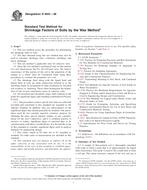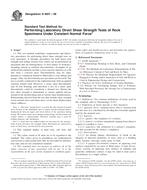Potřebujeme váš souhlas k využití jednotlivých dat, aby se vám mimo jiné mohly ukazovat informace týkající se vašich zájmů. Souhlas udělíte kliknutím na tlačítko „OK“.
ASTM D7382-08
Standard Test Methods for Determination of Maximum Dry Unit Weight and Water Content Range for Effective Compaction of Granular Soils Using a Vibrating Hammer (Withdrawn 2017)
Automaticky přeložený název:
Standardní zkušební metody pro stanovení maximální Dry jednotku hmotnosti a obsah vody rozsah pro efektivní zhutňování zrnitých půd pomocí vibračního Hammer
NORMA vydána dne 1.11.2008
Informace o normě:
Označení normy: ASTM D7382-08
Poznámka: NEPLATNÁ
Datum vydání normy: 1.11.2008
Kód zboží: NS-38326
Počet stran: 12
Přibližná hmotnost: 36 g (0.08 liber)
Země: Americká technická norma
Kategorie: Technické normy ASTM
Kategorie - podobné normy:
Anotace textu normy ASTM D7382-08 :
Keywords:
density, granular soil, soil compaction, unit weight, vibrating hammer, water content, Granular soil, Vibrating hammer, Water content--soil, ICS Number Code 13.080.20 (Physical properties of soil)
Doplňující informace
| Significance and Use | ||||||||||||||||||||||||||||||||||||||||||||||||||
|
For many cohesionless, free-draining soils, the maximum dry unit weight is one of the key components in evaluating the state of compactness of a given soil mass that is either naturally occurring or is constructed (fill). Soil placed as an engineered fill is compacted to a dense state to obtain satisfactory engineering properties such as shear strength, compressibility, permeability, or combinations thereof. Also, foundation soils are often compacted to improve their engineering properties. Laboratory compaction tests provide the basis for determining the percent compaction and water content needed at the time of compaction to achieve the required engineering properties, and for controlling construction to assure that the required unit weights and water contents are achieved. It is generally recognized that percent compaction is a good indicator of the state of compactness of a given soil mass. However, the engineering properties, such as strength, compressibility, and permeability of a given soil, compacted by various methods to a given state of compactness can vary considerably. Therefore, considerable engineering judgment must be used in relating the engineering properties of soil to the state of compactness. Experience indicates that the construction control aspects discussed in 5.2 are extremely difficult to implement or yield erroneous results when dealing with certain soils. 5.4.1, 5.4.2, and 5.4.3 describe typical problem soils, the problems encountered when dealing with such soils, and possible solutions to these problems. Degradation—Soils containing particles that degrade during compaction are a problem, especially when more degradation occurs during laboratory compaction than field compaction, as is typical. Degradation typically occurs during the compaction of a granular-residual soil or aggregate. When degradation occurs, the maximum dry unit weight increases so that the laboratory maximum value is not representative of field conditions. Often, in these cases, the maximum dry unit weight is impossible to achieve in the field. One method to design and control the compaction of such soils is to use a test fill to determine the required degree of compaction and the method to obtain that compaction, followed by the use of a method specification to control the compaction. Components of a method specification typically contain the type and size of compaction equipment to be used, the lift thickness, and the number of passes. Note 4—Success in executing the compaction control of an earthwork project, especially when a method specification is used, is highly dependent upon the quality and experience of the “contractor” and “inspector.” Gap Graded—Gap-graded soils (soils containing many large particles with limited small particles) are a problem because the compacted soil will have larger voids than usual. To handle these large voids, standard test methods (laboratory or field) typically have to be modified using engineering judgment. Gravelly Soils Possessing Low Angularity and High Percentage of Fines—Gravelly soils possessing low angularity and a high percentage of fines can lead to poor results for dry unit weight when using the wet/saturated method. However, when water contents at the time of compaction are near saturation with no free water, the dry unit weight achieved may result in a higher value than that from the dry method. Ultimately, during densification, the material may reach a saturated state. Therefore, for these soils, a water content of 1 or 2 % less than the wzav for the density achieved by using the dry method is recommended. This is more of a concern for testing in the 11-in. mold than in the 6-in. mold. An absolute maximum dry unit weight is not necessarily obtained by these test methods. Note 5—The quality of the result produced by this standard is dependent on the competence of the personnel performing it, and the suitability of the equipment and facilities used. Agencies that meet the criteria of Practice D 3740 are generally considered capable of competent and objective testing/sampling/inspection, and the like. Users of this standard are cautioned that compliance with Practice D 3740 does not in itself assure reliable results. Reliable results depend on many factors; Practice D 3740 provides a means of evaluating some of those factors. |
||||||||||||||||||||||||||||||||||||||||||||||||||
| 1. Scope | ||||||||||||||||||||||||||||||||||||||||||||||||||
|
1.1 These test methods cover the determination of the maximum dry unit weight and water content range for effective compaction of granular soils. A vibrating hammer is used to impart a surcharge and compactive effort to the soil specimen. 1.2 These test methods apply to soils with up to 35 %, by dry mass, passing a No. 200 (75-μm) sieve if the portion passing the No. 40 (425-μm) sieve is nonplastic. 1.3 These test methods apply to soils with up to 15 %, by dry mass, passing a No. 200 (75-μm) sieve if the portion passing the No. 40 (425-μm) sieve exhibits plastic behavior. 1.4 These test methods apply to soils in which 100 %, by dry mass, passes the 2-in. (50-mm) sieve. 1.5 These test methods apply only to soils (materials) that have 30 % or less, by dry mass of their particles retained on the ¾-in. (19.0-mm) sieve. Note 1—For relationships between unit weights and water contents of soils with 30 % or less, by dry mass, of material retained on the ¾-in. (19.0-mm) sieve to unit weights and water contents of the fraction passing the ¾-in. (19.0-mm) sieve, see Practice D 4718. 1.6 These test methods will typically produce a higher maximum dry density/unit weight for the soils specified in 1.2 and 1.3 than that obtained by impact compaction in which a well-defined moisture-density relationship is not apparent. However, for some soils containing more than 15 % fines, the use of impact compaction (Test Methods D 698 or D 1557) may be useful in evaluating what is an appropriate maximum index density/unit weight. 1.7 Two alternative test methods are provided, with the variation being in mold size. The method used shall be as indicated in the specification for the material being tested. If no method is specified, the choice should be based on the maximum particle size of the material. 1.7.1 Method A: 1.7.1.1 Mold—6-in. (152.4-mm) diameter. 1.7.1.2 Material—Passing ¾-in. (19.0-mm) sieve and consistent with the requirements of 1.2 and 1.3. 1.7.1.3 Layers—Three. 1.7.1.4 Time of Compaction per layer—60 ± 5 s. 1.7.2 Method B: 1.7.2.1 Mold—11-in. (279.4-mm) diameter. 1.7.2.2 Material—Passing 2-in. (50-mm) sieve and consistent with the requirements of 1.2 and 1.3. 1.7.2.3 Layers—Three. 1.7.2.4 Time of Compaction per layer—52 ± 5 s at each of 8 locations. Note 2—Method A (with the correction procedure of Practice D 4718, if appropriate), has been shown (reference thesis or paper) to provide consistent results with Method B. Therefore, for ease of operations, it is highly recommended to use Method A, unless Method B is required due to soil gradations not meeting Practice D 4718. Note 3—Results have been found to vary slightly when a material is tested at the same compaction effort in different size molds. 1.7.3 Either method, A or B, can be performed with the material in an oven-dried or wet/saturated state, whichever provides the maximum dry unit weight. 1.8 If the test specimen contains more than 5 % by mass of oversize fraction (coarse fraction) and the material will not be included in the test, corrections must be made to the unit weight and water content of the test specimen or to the appropriate field in-place density test specimen using Practice D 4718. 1.9 This test method causes a minimal amount of degradation (particle breakdown) of the soil. When degradation occurs, typically there is an increase in the maximum unit weight obtained, and comparable test results may not be obtained when different size molds are used to test a given soil. For soils where degradation is suspected, a sieve analysis of the specimen should be performed before and after the compaction test to determine the amount of degradation. 1.10 Units—The values stated in either SI units or inch-pound units are to be regarded separately as standard. The values stated in each system may not be exact equivalents; therefore, each system shall be used independently of the other. Combining values from the two systems may result in non-conformance with the standard. 1.11 The vibrating hammer test method may be performed in the field or in the laboratory. 1.12 This standard does not purport to address all of the safety concerns, if any, associated with its use. It is the responsibility of the user of this standard to establish appropriate safety and health practices and determine the applicability of regulatory limitations prior to use. |
||||||||||||||||||||||||||||||||||||||||||||||||||
| 2. Referenced Documents | ||||||||||||||||||||||||||||||||||||||||||||||||||
|
Podobné normy:
Historická
1.6.2009
Historická
1.7.2008
Historická
1.6.2008
Historická
1.6.2014
Historická
1.7.2008
Historická
1.1.2012
Doporučujeme:
Aktualizace technických norem
Chcete mít jistotu, že používáte pouze platné technické normy?
Nabízíme Vám řešení, které Vám zajistí měsíční přehled o aktuálnosti norem, které používáte.
Chcete vědět více informací? Podívejte se na tuto stránku.



 ASTM C1402-04(2009)..
ASTM C1402-04(2009).. ASTM D3877-08
ASTM D3877-08 ASTM D4943-08
ASTM D4943-08 ASTM D5334-14
ASTM D5334-14 ASTM D5607-08
ASTM D5607-08 ASTM D5778-12
ASTM D5778-12
 Cookies
Cookies
